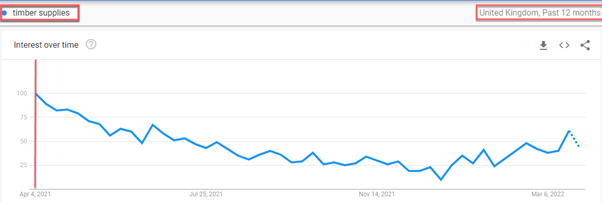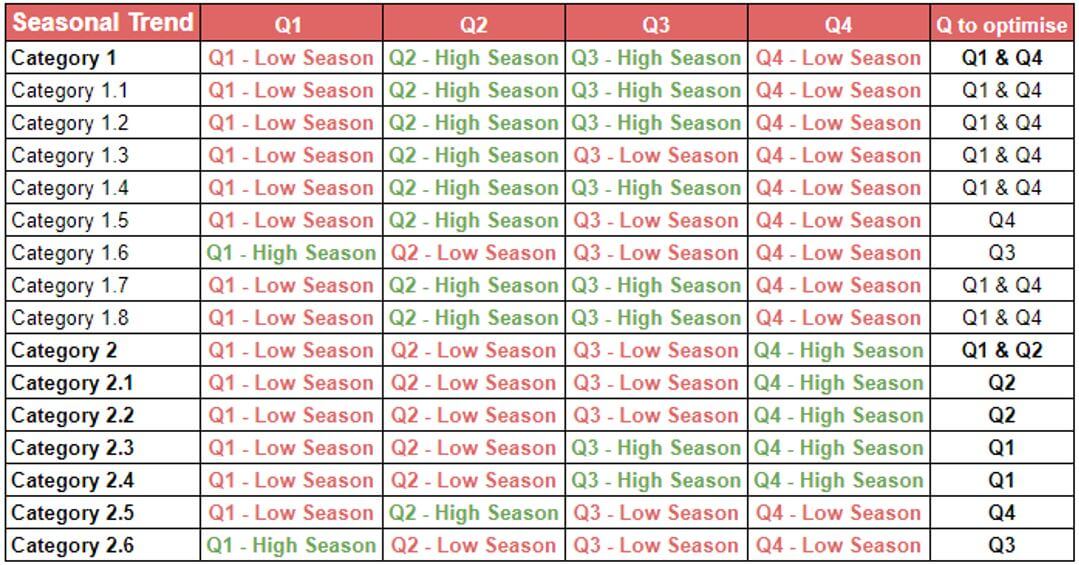Using seasonal product forecasting data to plan your SEO strategy
Optimising a website’s product or services range can involve implementing a variety of activities for a successful campaign. Add to this any limited resources and time restrictions and the overall strategy could become a significant challenge.
Understanding seasonal trends of your product range can help prioritise your SEO efforts from the start, leading to timely implementations to ensure your products are optimised at the highest point of conversions and resulting in an increased amount of revenue.
Let’s look at how you can extract seasonal search volume data and utilise it to forecast customer search demand and better plan your SEO campaign activities.
Importance of planning your SEO strategy
While there are certain aspects of a website you can address quickly to see increased rankings and revenue growth, the overall success of an SEO strategy comes from the pre-planning preparation. This is when you can ensure the optimisations you are implementing will be offering a positive long-term impact.
SEO is a gradual process of incremental gains over time. Making optimisations to a product range may see some initial ranking improvements, but the value will appear in the following months when a whole range would see increased conversations and revenue from successful quality improvement.
With small websites, the time to implement optimisations across a range can be minimal, meaning the results will follow quicker. However, when dealing with large ecommerce businesses or websites with large product ranges, it’s not practical to implement changes across all products in a short time frame.
This is where seasonal SEO prioritisation can heavily influence a strategy in focusing on key areas of value and planning optimisation activities to have a positive organic impact at the optimal point of customer demand.
What is Seasonal SEO Analysis
Seasonal SEO analysis is the process of identifying search demands of a website’s products and services to better coordinate and prioritise SEO activities.
The research you carry out can impact your SEO strategy towards category and product optimisations by ensuring you pre-emptively optimise sections of a website before they hit the peak season of the year and receive increased organic traffic.
Category pages are a great way to categorise your areas of focus for different stages of your SEO strategy. Gaining an understanding of the search demand of each category will provide you with insight for mapping out what parts of the site to focus on each month throughout the campaign.
Understanding the seasonal search demand at a product level will provide you with more granular targets,. You can select specific ranges to focus on and prioritise over other products that won’t offer as much value once optimised due to the reduced interest at that point of the year.
A regular builder’s merchant website is a prime example because the search trends vary throughout the year. Understanding at what point each category and product range receives the most search demand, based on historical data over previous years, will make your strategy more effective and return greater results.
While reviewing seasonal product trends is valuable to forecasting eCommerce trends and planning optimisations, websites that offer B2B products and services can still gain value from this research process. Understanding what points in the year your products receive the greatest amount of search demand can assist with ensuring you have your services optimised beforehand, allowing for strong ranking positions at the highest conversion point.
How to understand Category & Product Seasonal Trends For SEO
To understand seasonal trends for categories and products, you need to start with identifying the peak times of year where the customer demand is at its greatest point.
When focusing on a specific category or product range, Google Trends provides some great analysis to the search demand through Google.
Using product and category names, enter them into the search bar and you can compare the search demand over the course of the previous 12 months or greater:

From the example above, we can see the peak interest for ‘Timber Supplies’ is April, meaning the best time for optimisations to the category should be prior to this period.
Within Google Trends you can view the seasonal data going back to 2004, which provides insight as to how the general demand for the product range has changed over time.
You are also able to export the data for the term’s you have searched, allowing you to compare the trends of different categories and products within a spreadsheet so you can create your own custom visualisation of the data and forecast a trend for the upcoming year.
Using Search Volumes to Visualise SEO Seasonality Forecasting
The most effective method to understanding seasonality trends for your SEO strategy is through extraction of monthly search volumes for primary search queries to the site’s categories and products.
You need to ensure you carry out a successful SEO keyword strategy and track the highly relevant search queries for category and product landing pages.
Assuming you have keywords tracked for all pages, you can import the non-brand terms into a keyword tool such as the bulk keyword analyser in Keywords Everywhere, which, when exported, pulls the monthly search volume for every keyword over the previous 12 month.
See the example below for a sample of keywords:

Once you have the monthly search volume data, there are two suggested ways to present the data.
You can use colour scaling to show the period with the most and least search demand:

This works particularly well for reviewing product seasonality and identifying key areas where demand increases or decreases and by what extent.
Alternatively, you can work out the average of the yearly search volume for each keyword and mark each month as high or low if they exceed the average amount.

You could also take this a step further with averaging out every three months to calculate the high / low search demand by each quarter. This is a great way to summarise category seasonality for SEO:

Using Seasonal Data to Plan your Prioritise Your SEO Activities
Once you have collected all the seasonal search volume data and have a visual representation of category and product seasonal demand, you can start to map out activities for your SEO strategy.
Use the data to appropriately allocate optimisations to specific categories and products based on when specific areas experience high volumes of demand. As a best practise, the implementations should be made three months in advance of the high season, allowing time for search engines to process the changes and assign new ranking positions for the landing pages.
The specific optimisation activities that could be considered include:
- Page title changes
- H1 tag changes
- Refresh or production of optimised content
- Add structured data (seasonal pricing would be beneficial)
- Any required template changes
- Ensure CTAs are optimised for improved conversations
- Ensure commercial landing pages are indexed and canonicals are correct
- Resolve any technical issues
You should also consider and prepare product stock and availability fallbacks due to potential increased demand and organic traffic.
One example of this is to funnel customers to alternative similar products if a product becomes out of stock. Another is to have an option for customers to submit their email to be notified when the product is available again.
With planning out your SEO strategy, content production can also benefit the seasonal data trends you have identified. Producing content about a specific product, category, or event ahead of the peak time can help build relevancy beforehand and allows you to establish strong ranking positions. This enables you to capitalise on the increased demand from the start as well as when they reach maturity.
Using your Seasonal data for other channels
The SEO seasonal product data you have collected can also add value for other marketing channels and can play a large part in key business decisions in the future.
Channels such as paid, email, PR and social can all benefit from understanding when there will be increased demand for specific product ranges.
A business can also better prepare promotions and use the data to promote specific products for events when the demand is at its peak.